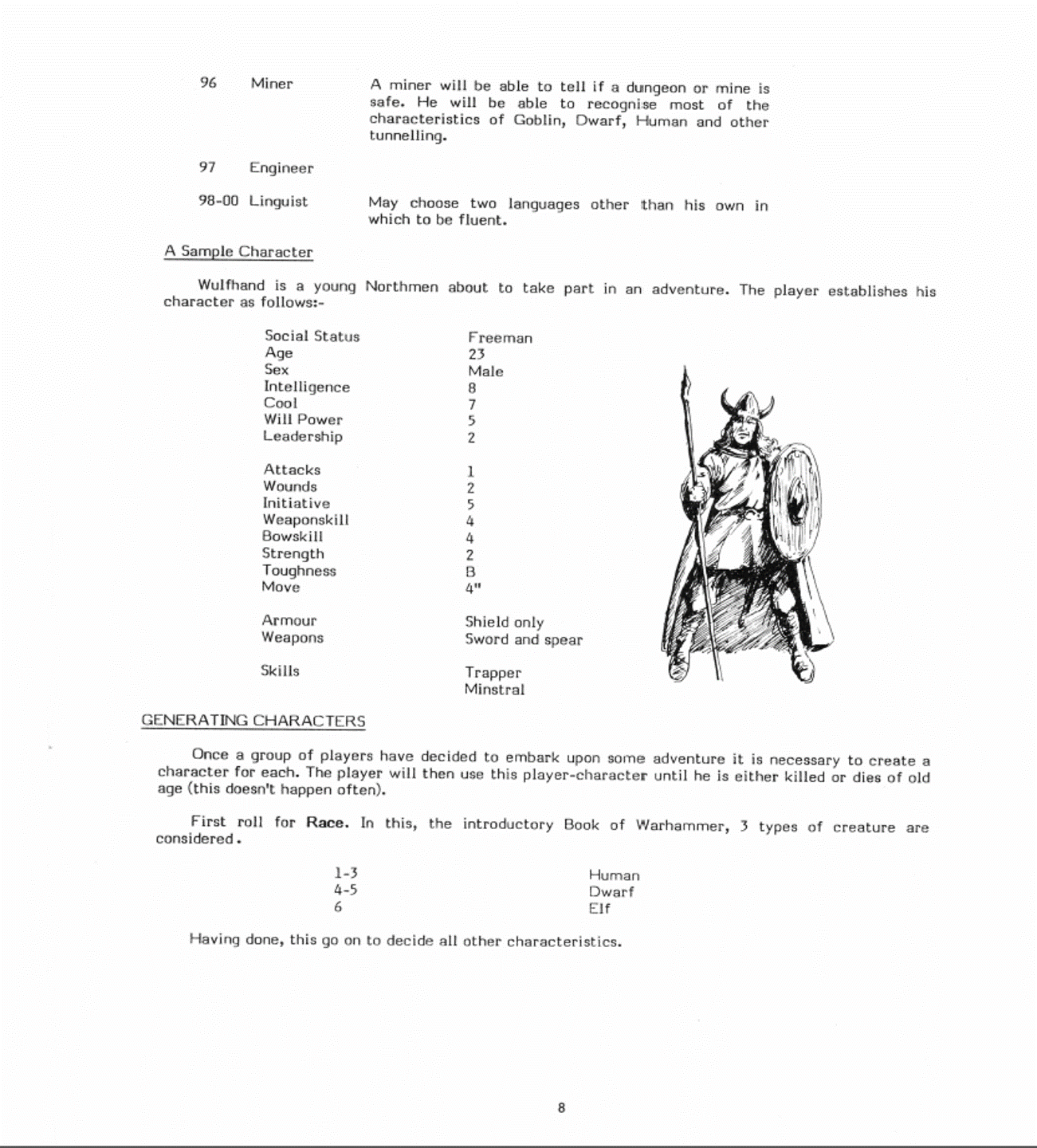This is the second in a series of posts discussing the design objectives of the authors of WFRP first edition. The first post in the series can be found here.
SKILLS
From an early stage we were presented with the choice of a percentage-based skill system, as in the RuneQuest family of games, or once-and-for-all skills, which was the system we chose. We made this choice for the sake of simplicity and ease of play; rather than keeping track of individual scores in dozens of skills, a player needs only to list the skills and tell the GM when the character has a skill which will modify one of the characteristic tests on which the game is based.
– WFRP Design Team, ‘Open Box X-tra’, White Dwarf 87 (March 1987)
WFB first edition used one-off skills, but I have struggled to identify any other precedent for WFRP‘s use of them. As far as I can recall, every major role-playing game before WFRP that used skills expressed them in terms of different levels. Such an approach seems entirely natural, as characters’ levels of expertise should be expected to vary. WFRP‘s once-and-for-all skills were, even at the time, a quite eccentric mechanism.


One-off skills in WFB first edition
It certainly had the very real advantage of simplicity. It is vastly quicker and easier to prepare NPCs with WFRP‘s first edition rules than with RuneQuest‘s third. The pairing of characteristic tests and skill bonuses was in theory an elegant simplification. It also enabled a colourful variety of skills that was unparallelled at the time
But it also created a whole range of problems. Some skills conferred a once-and-for-all ability. Others just offered a modest bonus to certain tests. There was even the oddity that Pick Lock was not, in fact, once and for all: it could be taken multiple times to gain cumulative bonuses.
Moreover, skills encompassed an odd range of attributes. Some were innate abilities, such as Night Vision. Others, like Very Strong, simply modified characteristics and added very little that could not have been expressed by characteristics.
Overall, the system was a mess, and the designers surely understood this. White Dwarf 89 published an article to repair some of the problems, but a true fix required a much more radical approach: for example, separating innate abilities from learned skills, distinguishing between technical and non-technical tasks, adding different levels of competence. There evidently wasn’t time to effect such changes in 1986, when Phil Gallagher, Jim Bambra and Graeme Davis came on board, but it is surprising that WFRP had not dealt with these issues earlier in the development process.
Anyway, I’d arrived thinking I was going to be part of creating “a better D&D“, only to discover the rules were mostly written. I felt like the Irishman in that joke where he gets asked by the tourist how to get to Dublin. “Well, I wouldn’t start from here,” he replies.
– Phil Gallagher, Realm of Chaos 80s
WFRP‘s skill system was certainly different. Just not in a good way.
The next post in the series will cover combat.
Title image used without permission. No challenge intended to the rights holders.
When did AD&D add Non-Weapon Proficiencies? These were “once-and-for-all” skills that were ‘tested’ by rolling against a characteristic.
LikeLike
Some non-weapon proficiencies appeared in Oriental Adventures (1985), but they weren’t added to the main game until the Dungeoneer’s Survival Guide (1986). I think that timing makes them more of a parallel development to WFRP than an antecedent, but you are right that perhaps WFRP’s one-off skills weren’t quite as eccentric as I have suggested.
LikeLike
The once-and-for-all skill system was in place when I arrived at GW in May 1986, and there wasn’t time to implement a percentage-based skill system by the end-of-September print deadline. Jim, Phil, and I found it a little limiting and frustrating, but we worked with it as best we could.
In the years since, I have observed that a lot of wargame rules use once-and-for-all skills, traits, and such, so I wonder if Rick, Hal, and Bryan were just doing what they knew when they designed this system. It certainly makes sense within a wargame rules set.
LikeLiked by 1 person
Once and for all skills actually mirror a lot of special rules that heroes in Hobbit Strategy Game and Warhammer battle/Agr of Sigmar have. However, I think they do make these games and WFRP slower than just looking up a % skill like Runequest, but then they do add to atmosphere and setting of the game too.
LikeLike
I felt like the 2nd edition approach pretty much fixed WFRP skills – separating them into Skills (which are tested against a specific characteristic and can also be trained further twice for +20% bonus) and Talents (which either give you an ability like Night Vision or Strike to Stun, or a bonus to a characteristic or skill). With those adjustments I think WFRP skills are relatively decent (although you do still have the old WFRP problem that every character starts of being crap at just about everything!)
LikeLike